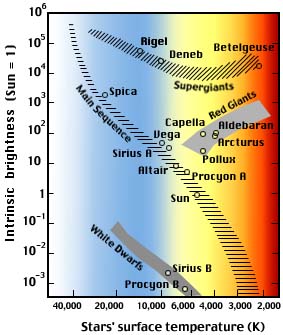Date: Mon Oct 2 13:35:55 2000
Posted By: Erika Gibb, Grad student, Physics & Astronomy/Origins of Life, RPI
Area of science: Astronomy
ID: 970168892.As
Message:
John,
Solar radiation has indeed changed with time, though this change is very
slow. Stars evolve along what is known as the Hertzsprung-Russell Diagram,
which is a plot of luminosity (the total rate of energy released over all
wavelengths) vs temperature. This plot can also be shown as abolute
magnitude vs spectral type since luminosity is related to absolute
magnitude and temperature is related to spectral type. An example of what
an H-R diagram looks like is shown below.
 Once a star reaches the main sequence, it moves very little until reaching
its turn off point and becoming a red giant. It does evolve, though, and
increases its luminosity while decreasing its temperature. For instance,
the sun was only 30 percent as luminous in the early part of the solar
system when Earth was a young planet. In 5 billion years, it will have
twice the luminosity it has now. This is shown below.
Once a star reaches the main sequence, it moves very little until reaching
its turn off point and becoming a red giant. It does evolve, though, and
increases its luminosity while decreasing its temperature. For instance,
the sun was only 30 percent as luminous in the early part of the solar
system when Earth was a young planet. In 5 billion years, it will have
twice the luminosity it has now. This is shown below.
 That's the long term picture. On the short term, the solar magnetic
activity cycle with its 11 year period causes small changes in the
radiation released by the sun over time. This fluctuation may be enough to
effect weather systems on Earth, such as the "Maunder Minimum" which was an
absence of sunspot activity from 1645 to 1705. This time is called the
Little Ice Age because global temperatures on Earth dropped about 1 degree
Fahrenheit (0.5 degree Kelvin).
For more information about H-R diagrams and stellar evolution, refer to any
introductory astronomy text book, such as Zeilik & Gregory "Astronomy &
Astrophysics"
Erika
That's the long term picture. On the short term, the solar magnetic
activity cycle with its 11 year period causes small changes in the
radiation released by the sun over time. This fluctuation may be enough to
effect weather systems on Earth, such as the "Maunder Minimum" which was an
absence of sunspot activity from 1645 to 1705. This time is called the
Little Ice Age because global temperatures on Earth dropped about 1 degree
Fahrenheit (0.5 degree Kelvin).
For more information about H-R diagrams and stellar evolution, refer to any
introductory astronomy text book, such as Zeilik & Gregory "Astronomy &
Astrophysics"
Erika
Current Queue |
Current Queue for Astronomy |
Astronomy archives
Try the links in the MadSci Library for more information on Astronomy.
MadSci Home | Information |
Search |
Random Knowledge Generator |
MadSci Archives |
Mad Library | MAD Labs |
MAD FAQs |
Ask a ? |
Join Us! |
Help Support MadSci
MadSci Network,
webadmin@www.madsci.org
© 1995-2000. All rights reserved.
 Once a star reaches the main sequence, it moves very little until reaching
its turn off point and becoming a red giant. It does evolve, though, and
increases its luminosity while decreasing its temperature. For instance,
the sun was only 30 percent as luminous in the early part of the solar
system when Earth was a young planet. In 5 billion years, it will have
twice the luminosity it has now. This is shown below.
Once a star reaches the main sequence, it moves very little until reaching
its turn off point and becoming a red giant. It does evolve, though, and
increases its luminosity while decreasing its temperature. For instance,
the sun was only 30 percent as luminous in the early part of the solar
system when Earth was a young planet. In 5 billion years, it will have
twice the luminosity it has now. This is shown below.
 That's the long term picture. On the short term, the solar magnetic
activity cycle with its 11 year period causes small changes in the
radiation released by the sun over time. This fluctuation may be enough to
effect weather systems on Earth, such as the "Maunder Minimum" which was an
absence of sunspot activity from 1645 to 1705. This time is called the
Little Ice Age because global temperatures on Earth dropped about 1 degree
Fahrenheit (0.5 degree Kelvin).
For more information about H-R diagrams and stellar evolution, refer to any
introductory astronomy text book, such as Zeilik & Gregory "Astronomy &
Astrophysics"
Erika
That's the long term picture. On the short term, the solar magnetic
activity cycle with its 11 year period causes small changes in the
radiation released by the sun over time. This fluctuation may be enough to
effect weather systems on Earth, such as the "Maunder Minimum" which was an
absence of sunspot activity from 1645 to 1705. This time is called the
Little Ice Age because global temperatures on Earth dropped about 1 degree
Fahrenheit (0.5 degree Kelvin).
For more information about H-R diagrams and stellar evolution, refer to any
introductory astronomy text book, such as Zeilik & Gregory "Astronomy &
Astrophysics"
Erika